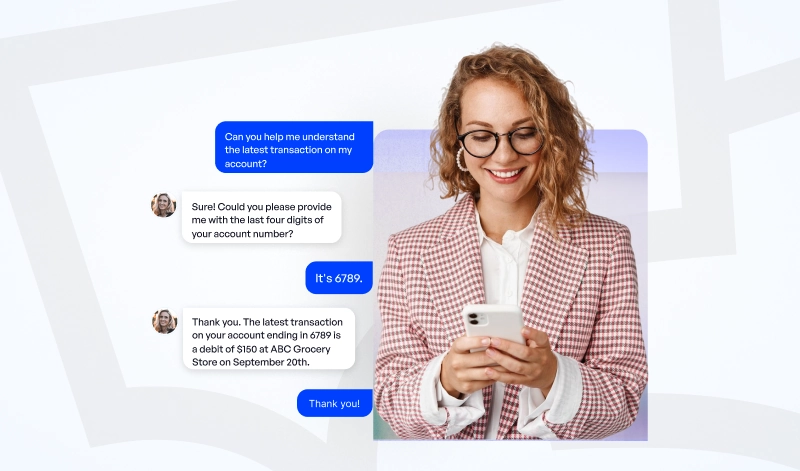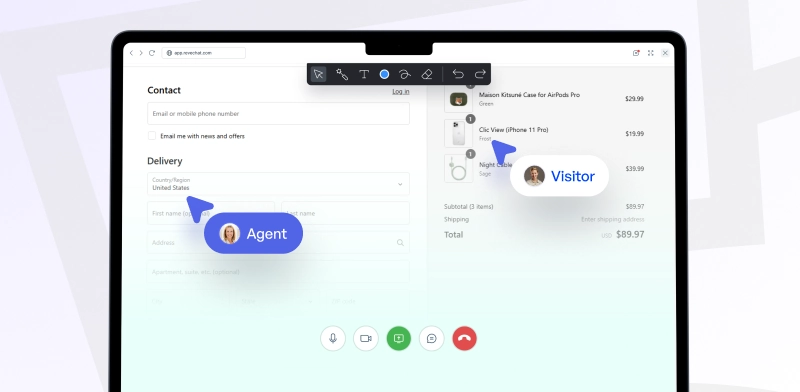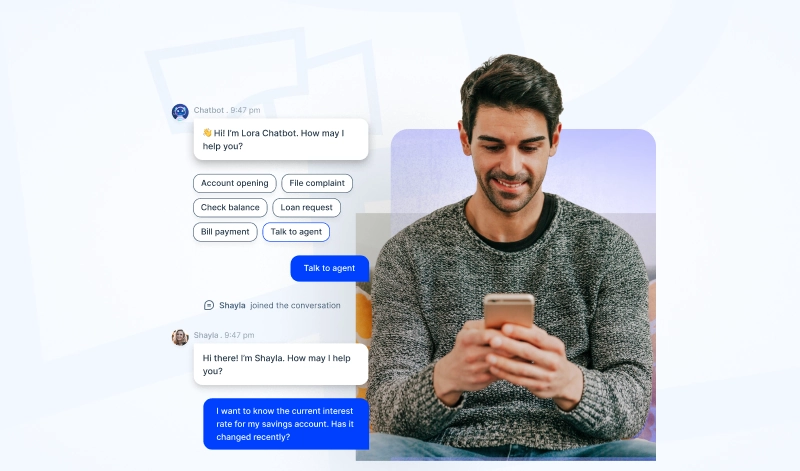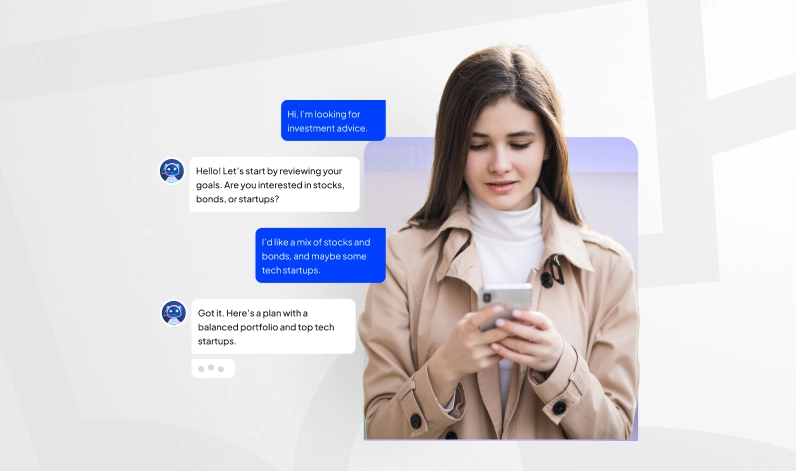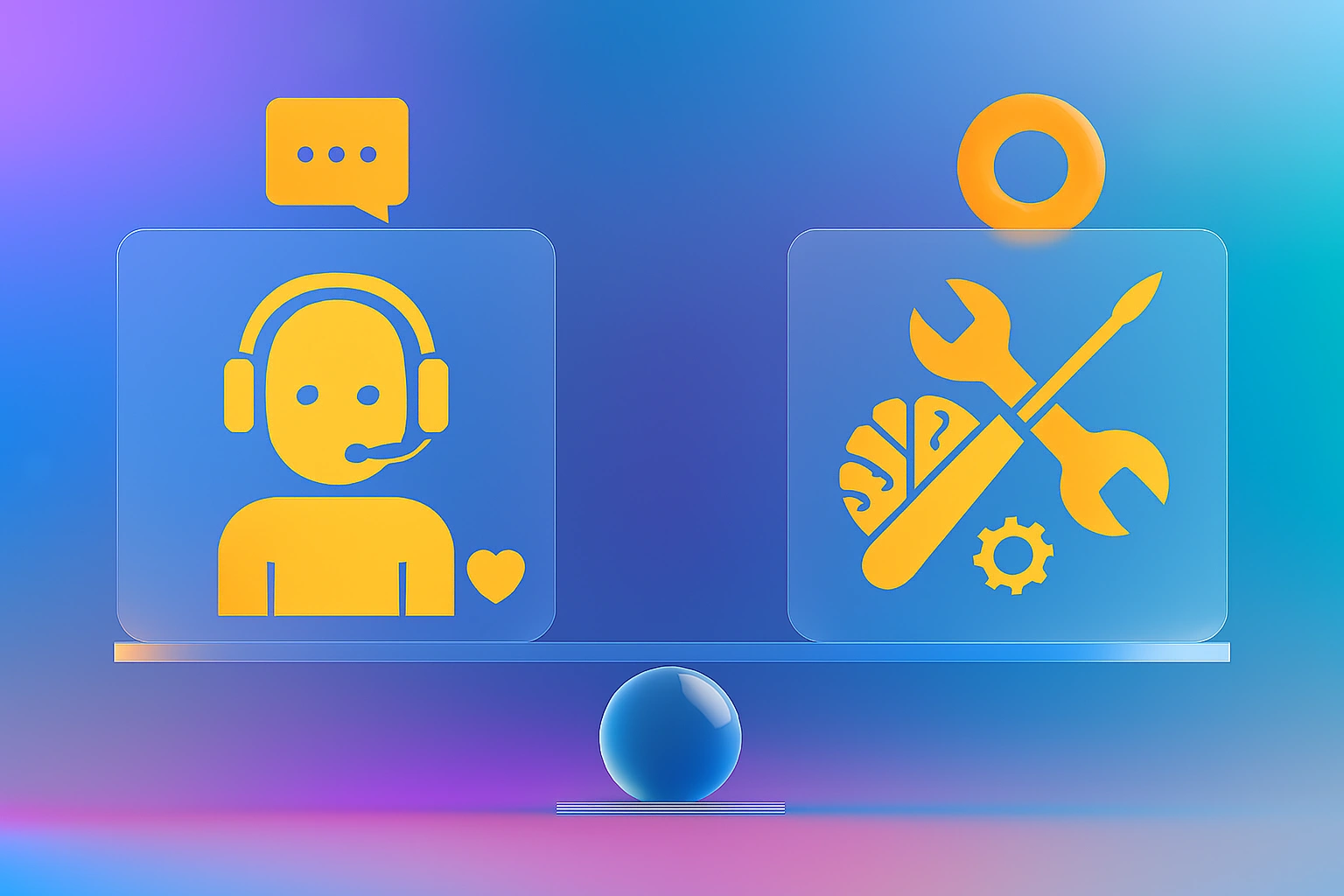9 Most Important Banking Customer Experience Trends (2025)
- September 18, 2024
- 11 mins read
- Listen

In recent days, we have found at REVE Chat, that our Banking customers have been experiencing a significant shift towards enhancing customer experience. Modern customers seek automated, personalized, and efficient services, prompting banks to innovate and adapt rapidly.
According to a survey for the banking industry customer trends, Talkdesk found that 82.5% of respondents of their survey sample consider CX to be important for customer loyalty and retention.
Now banks are rethinking how they deliver services from instant support to secure transactions and customer experience. Banks are meeting customers’ demands as CX-driven solutions like AI-powered chatbots, live chat platforms, and real-time collaboration tools emerge.
Top 9 Customer Experience Trends in Banking
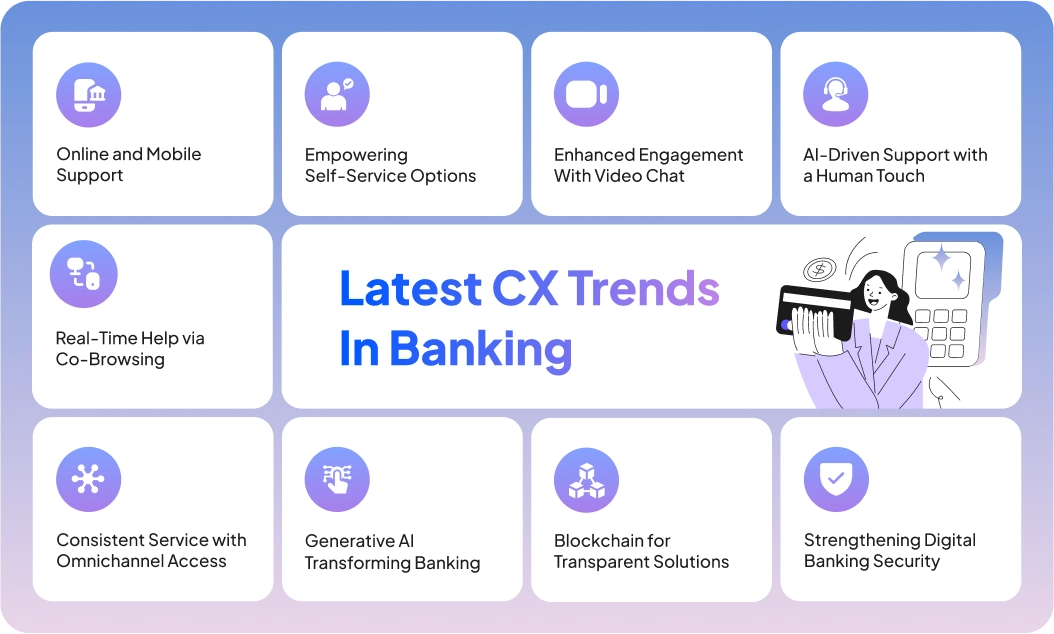
1. Online and Mobile Support
In today’s world, online and mobile banking are common. However, customers desire instant support while navigating these services. Whether it’s a live agent or a chatbot, having assistance readily available can greatly enhance the banking experience.
Following the trend, in the banking world, top-tier banks are not just integrating chatbots or live chat features into their online and mobile platforms—they’re making these options effortlessly accessible. This approach ensures that customers can swiftly resolve issues or get answers to their queries during online transactions. By utilizing advanced natural language processing, these chatbots can understand and respond to customer inquiries more effectively, providing personalized assistance that enhances user satisfaction.
This ensures that customers who prefer automated assistance or direct interaction with a human agent receive timely and effective support. Moreover, the integration of AI analytics allows banks to monitor customer interactions. It helps to continuously improve service quality and tailor responses to better meet individual needs.
2. Enhanced Engagement With Video Chat
This approach is becoming a key player in banking customer service. This trend is not just about adding a new feature; it’s about creating a more personal and secure customer experience. Leading banks are now offering video chat options on their websites and kiosks to elevate their service to new heights.
For example, one of REVE Chat’s customers from the MENA region has been using video chat to provide exclusive, high-touch service for its VIP clients to make them feel valued. Similarly, bKash, one of the world’s top three mobile financial service providers, has been using REVE Chat’s video chat options along with other features. Bkash has been using video chat for cross-border transactions, adding a layer of security and personalization that enhances user confidence and engagement.
3. Real-Time Help via Co-Browsing
Co-browsing has become an essential tool in delivering superior customer service in banking. This technology allows customer support agents to directly interact with customers’ screens, guiding them step-by-step through complex processes such as filling out forms, loan applications, or managing their accounts. By sharing the same screen, agents can visually demonstrate actions and provide immediate feedback, significantly enhancing communication clarity.
Basically, this eliminates the frustration customers often face when navigating complicated online tasks. It ensures that issues are resolved quickly and efficiently. Additionally, co-browsing enables agents to identify and address potential challenges proactively and reduce the likelihood of errors.
With co-browsing, banks can deliver a seamless, hands-on support experience that simplifies even the most intricate processes. Ultimately, it builds greater trust and loyalty with their customers.
4. AI-Driven Support With a Human Touch
The integration of AI chatbots has revolutionized customer service in banking by delivering instant and round-the-clock support that keeps customers satisfied. These intelligent assistants are no longer just a convenience, they’ve become a crucial component of modern banking experiences. According to a recent McKinsey report, banks implementing AI-driven chatbots have seen a 20% reduction in operational costs while enhancing customer satisfaction by 30%.
This technology provides rapid, precise responses to common queries—such as checking account balances and reviewing transaction history—ensuring customers receive swift and accurate assistance. Moreover, AI chatbots eliminate the need for customers to wait in long queues for simple inquiries. Their ability to manage multiple interactions simultaneously means help is always available. It boosts efficiency and meets customer expectations for prompt service.
However, employing a human agent alongside an AI chatbot elevates customer service to new heights. For a better CX, the handover options from bot to human agent must be seamless and intuitive. It allows customers to effortlessly access personalized assistance when needed. This approach makes a perfect balance between the efficiency of AI and the empathetic touch of human interaction possible.
One of the best examples of combining Chatbot and Human-agent is HSBC Singapore’s customer service. HSBC Singapore has won the best international bank in Singapore Award in 2024. This award highlights their dedication to providing excellent service through innovative solutions.
5. Consistent Service With Omnichannel Approach
If you put yourself in the customer’s shoes, you must expect a seamless experience across all touchpoints. For a modern bank, omnichannel can include the following channels:
i.Digital Channels
- Website
- Mobile App
- Facebook Messenger and comments
- Instagram DM and Comments
- Google Map Review
- YouTube
- Play Store Review
- Viber
- Telegram
- SMS
- Kiosk
ii. Traditional Channels
- Phone Call
- Onsite Visit
Supporting these digital channels will help a bank in the following ways
- It enables banks to target more Gen-Z and Millennium customers.
- Allows banks to collect a wide range of intent and to use those to personalize conversations with customers
- It’s a more customer-centric approach in addition to a transactional approach only
- Help Banks drive higher customer loyalty and reduce customer churn
- A traditional bank gets more prepared against a digital or new-generation bank
At REVE Chat, we found our banking customers are using all the above channels. But usually, not one customer uses all the above channels. It varies on the profile of their customers as well as their overall strategy. However, as an omnichannel customer engagement platform provider, we found it is very important to give seamless options for customers to change from one channel to another channel without changing the Agent.
6. Empowering Self-Service Options
While self-service portals on websites and mobile apps have become standard in the banking industry, self-serving chatbots are also getting into the trend. Customers are increasingly comfortable using chatbots because they mimic human conversation, making interactions feel more natural. As a result, services like password changes and card blocking or unblocking have become popular features for these self-service chatbots. Additionally, chatbots can provide instant assistance 24/7 reducing wait times and enhancing overall customer satisfaction.
This banking customer experience trend also opens up numerous opportunities, including but not limited to utility bill payments, small transactions, and eCommerce payments. By integrating chatbots into their services, banks can streamline operations, reduce costs, and empower customers to handle routine tasks efficiently. It allows human agents to focus on more complex issues. Click here to get more details on what banks can do with a Chatbot on REVE Chat’s platform.
7. Generative AI Transforming Banking
These days chatbots have opened up new horizons for customer experience (CX) by integrating large language model (LLM) capabilities into banks’. With the help of LLM technology, chatbots can deliver more personalized responses, understand customer intent with greater accuracy, and facilitate language translation. It makes communication more accessible to a diverse customer base. This conversational approach enhances user engagement and satisfaction.
To avoid any risks associated with deploying LLMs, banks can limit bot training to their website content, FAQs, and internal documents. It ensures that interactions remain relevant and secure.
Several LLM models are available for banks, at REVE Chat, we are offering two main options:
- Using ChatGPT
- Using a Customized LLM Model
Performance-wise, both types of models are comparable, but there are notable differences in cost structures. REVE Chat charges a flat monthly fee for the API, with variable costs transparently associated with ChatGPT usage. For the customized LLM model, if banks use REVE Chat’s cloud version, charges are based on the number of tokens used, which is significantly less than the costs associated with ChatGPT.
In contrast, if banks choose on-premise deployment, there will be no variable costs, only a one-time deployment fee that makes it a potentially more cost-effective solution in the long run.
8. Blockchain for Transparent Solutions
Blockchain technology can significantly enhance customer experience (CX) in the banking sector by providing secure, transparent, and efficient financial services.
Here are some key ways it can be utilized:
i. Improved Security and Trust
- Blockchain’s decentralized and immutable ledger ensures secure transactions and reduces the risk of fraud and data tampering.
- Customer data is protected through encryption which makes it difficult for hackers to alter records.
ii. Streamlined KYC (Know Your Customer)
- Blockchain can store KYC data in a secure and shared database that is accessible to multiple institutions. It reduces duplication and manual verification.
- This results in faster onboarding and a smoother account opening process for customers.
iii. Faster and Cost-Effective Transactions
- Traditional banking transactions, especially international ones, can take days to process. Blockchain enables real-time settlement, cutting transaction time significantly.
- With reduced intermediaries, transaction costs are also lowered, enhancing customer satisfaction.
iv. Secure Cross-Border Transactions
- Blockchain removes the need for intermediaries in cross-border payments, allowing for lower fees and faster processing, making international transactions smoother for customers.
v. Enhanced Transparency
- Blockchain’s transparent nature allows customers to track the status of their transactions in real-time.
- This transparency builds trust and improves customer relations by offering greater clarity around financial services.
vi. Loyalty and Reward Programs
- Banks can create blockchain-based loyalty programs where points are tokenized. Customers can redeem points across various platforms seamlessly, enhancing engagement.
vii. Personalized Banking Experiences
- Data collected on the blockchain can be analyzed to gain deeper insights into customer behavior, enabling banks to tailor products and services.
- This data-driven approach allows banks to offer personalized recommendations and improve CX.
Incorporating blockchain into banking operations not only improves security and transparency but also delivers faster, more personalized services, enhancing overall customer experience
9. Strengthening Digital Banking Security
Cybersecurity is a critical factor in establishing and maintaining customer trust. When customers feel confident that their transactions and personal data are secure with the bank, their overall experience improves. It leads to increased engagement and loyalty. However, strict security measures can sometimes result in a negative user experience, particularly during login processes, onboarding, or other interactions.
Banks must strike a delicate balance between implementing strong security protocols and ensuring seamless, user-friendly authentication methods. Advanced tools and technologies can help provide robust security without sacrificing ease of access, speed, or convenience on web and mobile platforms.
In addition to overall security measures, banks must also prioritize security for their transactional or self-service chatbots. Some effective security measures, related to better CX, include:
- Multi-factor authentication (MFA) adds an extra layer of protection by requiring two or more verification steps.
- Implementing PCI DSS certification to ensure secure data transfer, particularly for payment and transaction information.
- Ensuring data storage security, including encryption and regular audits, to prevent breaches.
- Enabling face recognition for identity verification reduces risks such as fraud or unauthorized access in the event of phone theft.
Moreover, banks should adopt real-time monitoring and AI-driven threat detection to proactively identify potential security threats before they can cause harm. This includes employing advanced algorithms to detect unusual account activity or suspicious transactions. These proactive measures can significantly reduce the chances of cyberattacks and enhance overall customer confidence.
Learn More: Digital banking in Bangladesh
Conclusion
Creating an exceptional customer experience (CX) is fundamental to thriving in today’s banking sector. The trends discussed in this blog—ranging from AI-driven support and omnichannel engagement to co-browsing and blockchain—show how banks are transforming their services to meet evolving customer expectations. By integrating advanced engagement tools like video chat, co-browsing, and customized AI solutions, REVE Chat is partnering with banks to provide secure, personalized, and seamless interactions across every digital touchpoint.
As a dedicated partner in the banking sector’s CX journey, we understand that every customer interaction matters. Our goal is to work closely with banks to build stronger relationships and enhance trust by leveraging innovative technology. In a rapidly changing environment, adopting a customer-first approach not only drives satisfaction and loyalty but also positions banks as pioneers in delivering meaningful, human-centric experiences. Together with our clients, we are shaping the future of digital engagement and setting new standards for what exceptional CX looks like in the banking industry.
Ready to see how our solutions can transform your banking customer service? Book a demo to let us walk you through, or sign up for a free trial to explore on your own.
Frequently Asked Questions
The future of customer experience in banking is driven by AI and automation that allows banks to deliver personalized, real-time services. Remember, customers will expect seamless, omnichannel experiences, emphasizing convenience, security, and personalized financial solutions.
Customer experience in banking is customers’ overall perception based on their interactions with a bank. It includes everything from the ease of using mobile apps and online banking platforms to in-person interactions, service speed, and the bank’s ability to resolve issues efficiently and transparently.
If you want to improve customer service in banking, you have to focus on delivering personalized solutions through data-driven insights. It ensures smooth and efficient digital services and offers multi-channel support. Plus, collect feedback to address pain points and provide proactive customer service that enhances satisfaction and loyalty.
You can use customer satisfaction metrics like NPS ( Net Promoter Score) and CSAT (Customer Satisfaction Score) to measure customer experience. Additionally, track churn rates, customer complaints, and digital engagement analytics, while also analyzing customer feedback to identify areas for improvement in service and support.


